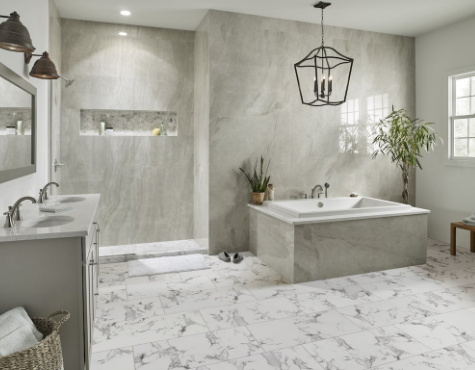Have you ever stepped into your shower and felt your foot slip just a little? It’s scary, right? That’s where slip-resistant floor tiles come in. They’re designed to help you stay steady, even when things get wet and soapy.
With so many tile options, choosing one that “looks” nice but doesn’t keep you safe is easy. In this post, we’ll walk through what makes a tile slip-resistant, why design doesn’t have to come at the cost of safety, and the biggest mistakes people make when picking shower tiles.
So before you shop, ensure you’re stepping on the right stuff.
What Makes a Tile Truly Slip-Resistant? (Hint: It’s Not Just Texture)
Not all shower tiles are created equal. Some may look safe, but it’s a different story once they’re wet. So, what makes a tile slip-resistant?
First, it’s about the surface. Tiles with a rougher or textured finish usually offer better grip. However, it’s not just the texture that matters. The material, size, and even the spacing between tiles all play a role. Smaller tiles often have more grout lines, which add traction.
Also, you’ll hear something called the COF rating, which is short for coefficient of friction. It sounds technical, but it simply tells you how slippery a tile is when wet. The higher the number, the better the grip. So, if you want a safe shower floor, always check that rating.
Still unsure what to look for? That’s where expert insight helps.
For real advice, check out expert advice from Bruno Mendolini. They break it down in a way that makes sense.
In the end, don’t guess. Try to know what makes a tile safe before it’s installed.
Best Slip-Resistant Tile Types for Shower Floors
When it comes to safe shower flooring, you’ve got more options than you might think. Some tiles aren’t just safer. They look great, too. So, which ones should you consider?
- Porcelain tiles are a solid pick. They’re durable and water-resistant, and when textured, they add just enough grip. Even better? They’re easy to clean.
- Then there are mosaic tiles. These are made up of smaller pieces, which means more grout lines. And more grout equals more traction. That’s a win for both safety and style.
- If you’re into a natural look, stone tiles like slate or pebbled surfaces also work well. Just make sure they’re sealed properly, or they’ll get slippery over time.
Each option has its pros and cons. So, it really depends on your budget, taste, and how much cleaning you’re okay with.
Want to see what these look like in real bathrooms? Head over to Tile Choices Shower Floors for some solid inspiration.
Big Design Question: Can You Have Safety and Style?
Short answer? Yes, you totally can.
A lot of people think slip-resistant tiles look rough or boring. But that’s old news. These days, tons of options look amazing and keep you steady in the shower.
For example, some textured porcelain tiles come in sleek, modern finishes that blend into high-end bathrooms. Mosaic tiles offer color and pattern without losing grip. Even natural stone tiles can look spa-like while adding traction.
So, you don’t have to settle for something that “just works.” The right slip-resistant tile can pull your whole bathroom design together while keeping you safe.
With wise choices, you really can get the best of both worlds. Safe doesn’t mean ugly anymore, and stylish doesn’t mean slippery.
Common Mistakes When Choosing Shower Floor Tiles
It’s easy to get caught up in how a tile looks. But in a shower, one wrong choice can lead to slips. So, let’s talk about the most common mistakes people make when picking shower floor tiles.
First, choose glossy tiles. They might look fancy, but once they get wet? They turn into a skating rink. Always go for matte or textured finishes instead.
Second, ignoring tile size. Big tiles may mean fewer grout lines, but that also means less grip. Smaller tiles, especially mosaics, give your feet more traction because of all the grout in between.
Third, skip expert advice. A quick chat with someone who knows tiles can save you from a costly redo later.
Not sure who to ask? Bruno Mendolini’s expert advice is a great place to start.
Lastly, don’t forget about maintenance. Some tiles look great at first but become slippery over time if not cleaned or sealed properly.
What to Ask Before You Buy: A Quick Buyer’s Checklist
Before you grab that “pretty” tile, pause for a second. Here’s what you need to ask:
- Is it made for wet areas?
Some tiles are designed for walls, not floors. And not wet feet. Always check if it’s rated for showers.
- What’s the slip-resistance rating?
Look for the COF rating (remember that from earlier?). The higher, the safer. If it doesn’t say, ask.
- How much grout will there be?
Smaller tiles usually mean more grout lines, which helps with traction. It’s a simple trick that works.
- Is it easy to clean without getting slippery over time?
Some tiles lose grip if soap scum builds up. You want one that stays safe and looks clean.
- Does it match your lifestyle?
Have kids or older adults at home? Then, safety should be the top priority, even more so than looks.
Asking these questions now means fewer regrets later. So, take a few extra minutes before you buy. Your future self (and your feet) will thank you.
Wrapping Up
Choosing the right shower tile isn’t just about looks. It’s about safety, too. With slip-resistant floor tiles, you reduce the risk of falls while still keeping your bathroom stylish.
We covered what makes a tile safe, the best types to consider, and common mistakes to avoid. Plus, we shared a checklist to guide your decision.
In the end, safety and design can go hand in hand. So before you buy, take a moment to think it through. After all, the right tile doesn’t just look good. It helps you feel confident every time you step into the shower.



































